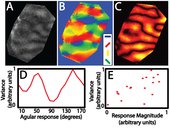Highlight
Visualizing How the Brain Sees Orientation
Achievement/Results
Using a technique called intrinsic signal optical imaging, Corey Flynn and his advisor Professor Justin Crowley at Carnegie Mellon University in Pittsburgh, Pennsylvania have shown that the brain sees oblique lines differently than horizontal or vertical lines. The technique works by shining red light onto the surface of the cortex and measuring the amount reflected back at each spot, which correlates with the activity of neurons in that region. By varying the orientation of a stimulus line while looking for the maximal response, experimenters can determine the preferred orientation for each bit of cortex, forming an orientation preference map as shown in part B of the figure. They can also measure the strength of the cells’ responses to stimuli, forming a response magnitude map shown in part C.
An NSF IGERT fellowship allowed Flynn to spend time in the lab of Dr. Fred Wolf of the University of Gottingen, Germany, studying specialized analysis strategies for geometric quantification of intrinsic signal optical imaging maps. Working with Dr. Wolf’s group, he developed software tools to estimate the variance in neural response under a novel stimulation technique developed in the Wolf lab. Flynn took what he learned back to the Crowley lab at Carnegie Mellon, where he applied his tools to real data sets recorded from ferret visual cortex.
Flynn and Crowley found that not only do neurons sometimes respond differently to the same stimulus, but the variance of neural responses is not uniform across the orientation map. The response variance map in part A of the figure shows a periodically varying structure. The correlation between response variance and orientation preference (part D of the figure) shows that variance is greatest in regions that code for oblique orientations, and least in regions that prefer horizontal or vertical orientations. Variance is also positively correlated with response magnitude (part E of the figure).
Address Goals
This research has uncovered a new phenomenon in the organization of the mammalian visual system. Efforts to understand the visual system will lead to more general insights into how the brain processes information, and have many potential applications, ranging from aid to persons with visual impairments to the development of improved computer vision systems.
This new result is a product of combining cutting edge experimental techniques with sophisticated mathematical tools for extracting the maximum amount of information from noisy data. It illustrates the success of the interdisciplinary approach to science fostered by the IGERT program.






